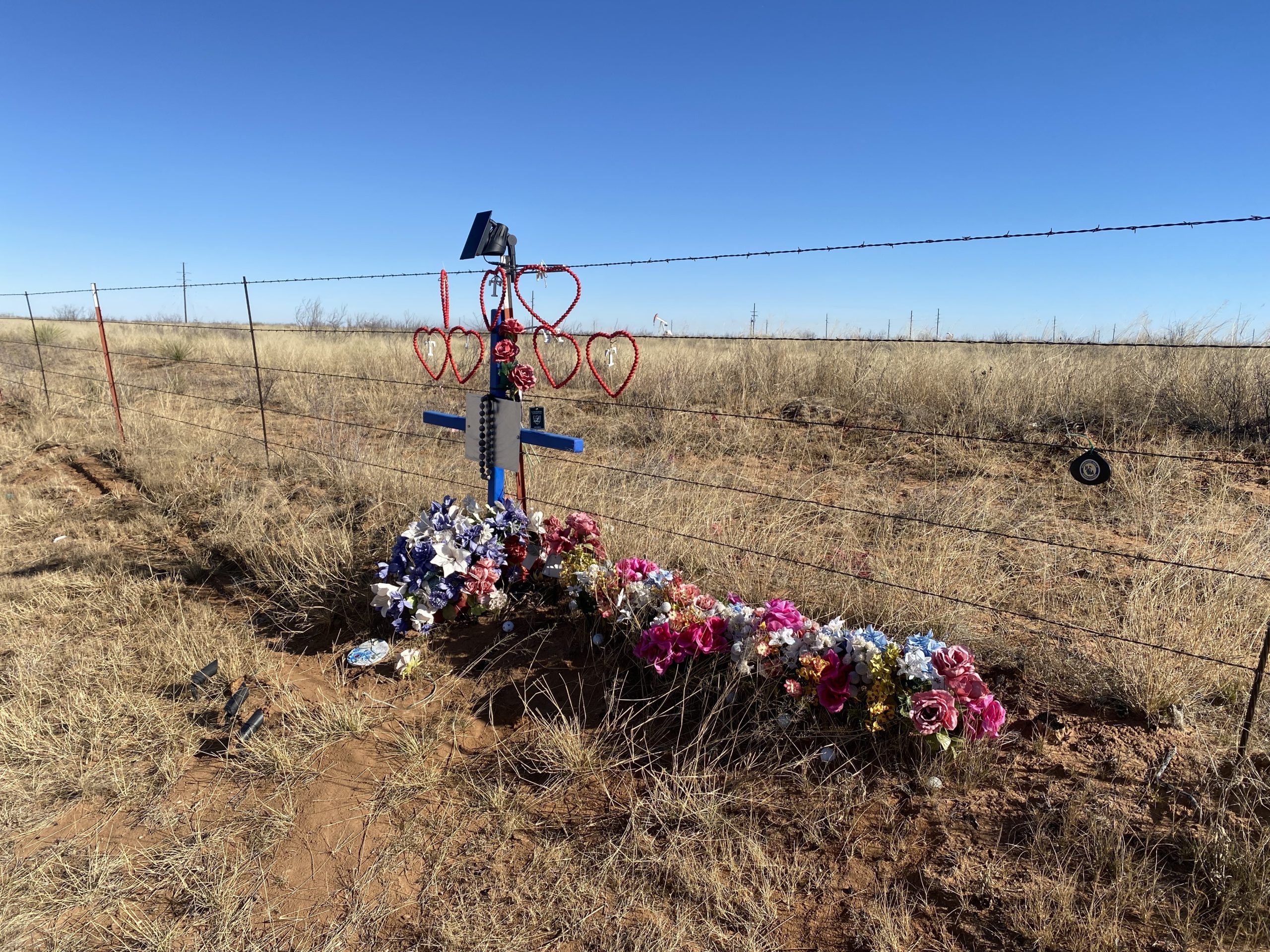HOBBS, N.M. — When Dayton Price woke up, he was burning alive.
Flames engulfed the van carrying Price, seven teammates and his coach. There was no time to think. He smashed a window and dragged himself to the pavement before trying to get his friends out, as well. Only Price, 19, and Hayden Underhill, 20, were able to escape the inferno, and even then just barely. It wasn’t long before helicopters landed at the crash site and took them to hospitals some 100 miles away to save their lives.
The National Transportation Safety Board said Henrich Siemens, 38, and his 13-year-old son were in a white Ram 2500 truck southbound on Farm-to-Market Road 1788 deep in the West Texas plains when it crossed the center lane at 8:17 p.m. on March 15, 2022, colliding head-on with a van carrying eight members of the University of the Southwest golf team and its coach. The team was about 30 minutes into its 90-minute return ride to campus.
Nine of the 11 people involved died. The NTSB later ruled Siemens had methamphetamine in his system.
Victims included 26-year-old Tyler James, the golf coach who was driving the van, as well as golfers Jackson Zinn, 22, of Westminster, Colorado; Karisa Raines, 21, of Fort Stockton, Texas; Travis Garcia, 19, of Pleasanton, Texas; Mauricio Sanchez, 19, of Mexico; Tiago Sousa, 18, of Portugal; and Laci Stone, 18, of Nocona, Texas.
The six players and coach of the University of the Southwest golf team who died in the crash on March 15, 2022.
A final report has yet to be released. Why the truck crossed the centerline remains unknown. Price spent 86 days in the hospital before he went home. A year after the crash, he and Underhill, along with their former teammates not involved in the crash, families of those who died and the USW community are still coping with the pain and loss.
There are feelings of guilt and questions that can never be answered about a moment that changed their lives forever. At times, it’s almost too much to bear. But all know they have to move forward.
The scene of a fatal wreck that claimed the lives of six University of the Southwest golfers and the team’s coach, plus two others, on March 15, 2022, on Farm-to-Market Road 1788 in Andrews County, Texas (Eli Hartman/Odessa American via AP)
Each month, Price and Underhill join a Zoom call with the remaining members of the USW golf team and their former teammates’ family members. It’s a group therapy session. They laugh. They cry. They love.
“None of us should actually really know each other as well as we do,” Laci Stone’s mother, Chelsi, said.
“We’re almost mad at the fact we have to,” added Laci’s father, Haydan.
The crash scene
Farm-to-Market Road 1788 facing south on Jan. 26, 2023 (Cameron Jourdan/Golfweek)
It’s a chilly January morning, but the sun bakes the pavement of Farm-to-Market Road 1788 in Andrews County, Texas. It’s a rural stretch of two-lane highway that connects Midland to Seminole, with the town of Andrews a mere 10 miles to the west. Half a mile north of the intersection with State Highway 115 is a straightaway where the yellow centerline is faded, thanks to the wearing effects of oil-field traffic and West Texas weather.
The road itself is rough, mimicking the landscape that surrounds it. Oil pump jacks repeatedly pound the Earth, marking the horizon in every direction. The speed limit is 75 mph, though that seems more of a recommendation. Cars, trucks and semis blaze through this stretch, swirling up dust.
It’s easy to miss, but glance to the east side of the road and you see it: two blue pieces of metal resembling a cross affixed to the post of the barbed wire fence. Purple, white and pink flowers, illuminated by solar-powered lights, hug the dirt, and hearts sway from barbed wire. In the middle of each of the seven hearts is a letter, the first name of each deceased USW golfer. There also remain seven golf balls in the dirt, untouched and seeking refuge beneath the bouquets of flowers cascading over them.
Debris remains scattered around the memorial remembering the six players and coach of the University of the Southwest golf team that died March 15, 2022, in a crash coming back from a tournament. (Cameron Jourdan/Golfweek)
Closer to the highway is evidence of how this memorial came to be: shreds of rubber, shattered pieces of a headlight, scraps of metal. Faded colors and splotches of dirt tattoo the remains, making it seem as if they’ve been there forever.
On the west side of the road is a smaller tribute, laying on a bed of white rocks. It’s again surrounded by rubber and shrapnel. There are two bouquets, one on either side of the rocks. Behind those are pairs of crosses, one sculpted from tree bark and the other with the names Henry Siemens and Ricky Siemens. Beneath the names are dates of birth and death. Dried, crunchy brown roses lay on the rocks, guarded by two lights that brighten the somber scene.
A memorial is set up for Henry Siemens and Ricky Siemens. Henry, 38, was driving the truck with his 13-year-old son that crashed into the University of the Southwest team van. (Cameron Jourdan/Golfweek)
The memorials are the most colorful, powerful and emotional markers along Farm-to-Market Road 1788. The flowers dance in the breeze as vehicles pass. The spray-painted markings from law enforcement on the highway have all but faded, though the horrors have not.
The administrator
Steve Appel’s office is typical for an athletic director at a small college.
Baseball jerseys line the walls as Appel, also the baseball coach and facilities director, is a jack-of-all-trades for USW. His desk is cluttered with papers, though they’re organized in a way only he will understand. There are couches surrounding a table next to his desk, often a place for fellow coaches or athletes to come spend their time and escape the outside world. It is often Appel’s escape, too.
“There are no guidelines to this,” he said, fighting back tears.
Appel went to college in Connecticut at a school with about 8,000 students, but that wasn’t for him. He craved an even smaller school environment. He enjoys the minuscule details, even down to cutting his baseball field’s grass. USW was unique. Now in his ninth year there and with no kids of his own, the students and staffers on this small New Mexico campus – attendance is roughly 1,000 total counting virtual students and 300 on campus – became his family.
A sign on the University of the Southwest’s campus on Jan. 25, 2023 (Cameron Jourdan/Golfweek)
That’s why his job changed forever when his phone lit up on March 15, 2022. USW’s baseball team had just completed a game in New Orleans, 16 hours from home. Sitting in his hotel room, Appel began receiving bits of information from someone back in Hobbs.
“There’s been a crash.”
“It involves the golf team.”
“Fatalities.”
Appel still remembers the emptiness he felt as the reports dripped in.
“It was a tough, tough night because you weren’t (there) and didn’t know all the details,” Appel said. “You’re still trying to take care of 40 kids on the road. It’s not like something where we can get on the bus, and in a couple hours we’re back home.”
Eventually, all the details came to light. The two-day drive back home from Louisiana seemed to take two weeks. The following days, weeks and months didn’t pass any quicker.
The news vans and national spotlight left Hobbs, but Appel and the students still on campus, many of whom were athletes, continued with daily life. Questions remained. Questions about the future of the golf team and replacing the coach. When would they post this job?
The answer was always the same: whenever Appel was ready.
He knew he couldn’t replace Tyler. There would never be another like him. Inside the USW athletics building, Tyler’s office remains mostly untouched. Papers remain scattered on his desk. There’s a water bottle there, too. A putting mat is tucked away on top of a shelf.
“There are still no answers.”
The survivors
Halie Cruz was shaking. Her stomach quivered.
“I can’t do this,” she thought to herself. But she couldn’t stop. She had to continue on.
On Oct. 24, 2022, more than six months after the accident, Cruz was in Plainview, Texas, the halfway point between Amarillo and Lubbock. The USW golf teams played at Plainview Country Club in their first tournament since the crash.
Cruz and Taylor Phillips both competed in the TankLogix Collegiate in Midland on that fateful March day alongside their teammates, but instead of getting back on the van to return to campus, they stayed with family. Little did they know the impact of that decision.
Cruz and Phillips are two of the four members of the USW golf teams who decided to return to the Mustangs, along with Harrison Kessler and Phillip Lopez on the men’s side. It’s conceivable the golf teams would’ve been cut had the four not returned to school after the crash.
No one would’ve blamed them if they left.
Yet here they were, competing in the Wayland Baptist Invitational in Plainview. Cruz and Phillips played as individuals because only three members remain on the women’s golf team this season. Meanwhile, Kessler and Lopez are with three new teammates on the men’s side. The core four were eager to play well, but the scores didn’t matter. There was more on the minds of these student-athletes than hitting good golf shots.
“I just wanted to go out and just do amazing,” Kessler said. “And that just can’t happen. That’s a hard thing to deal with.”
From left, Taylor Phillips, Halie Cruz, Phillip Lopez and Harrison Kessler pose with a flag during the B5 Foundation tournament. (Courtesy of University of the Southwest)
In the days following the tragedy, Kessler, Lopez, Cruz and Phillips all went home. Kessler tried to block the incident from his mind. As time went on, though, the pain became harder and harder to deal with. He wanted to stay strong and say the right things. But there are no answers. Lopez went home, working to keep his mind busy. Cruz spent time alone – and with her dogs. Phillips relied on her hamster, giving her a reason to get up each day and stay active.
The four checked in on one another. As close as they were before the crash, they became inseparable after. Eventually, it was time to decide whether to return. There was survivor’s guilt and second guessing and some uncertainty ahead.
“At first, I was like ‘No, I’m not coming back,’ ” Cruz said. “But I needed to go back. I needed to finish what I started.”
“For me, it was to honor them,” Phillips added.
The return was, as is to be expected, difficult and at times uncomfortable, often with time spent in classrooms and working through homework once tackled with teammates. Others on campus tried to offer sensitivity, but the group has been treated differently for certain. A new coach, RJ Lester, is yet another reminder that life has changed, but he is learning each day how to lead a group that has been through severe trauma.
And then there’s the golf course, Rockwind Community Links, where the four have memories of qualifying in the snow and laughing through numerous practice rounds. New golf bags will never have the meaning of the old ones. In some rounds, the four are trying to get better, yet in others, they’re simply seeking solitude.
University of the Southwest golfers (from left) Phillip Lopez, Jonny Flores and Halie Cruz visit a memorial on March 17, 2022, at the Rockwind Community Links in Hobbs, N.M., erected for the victims of the USW golf team’s vehicle crash. (Odessa American/Odessa American via AP)
For Kessler, Lopez, Cruz and Phillips, it’s about perseverance. It’s the reason they returned to this tiny town. It is, in their eyes, what their teammates would have wanted. It’s what Tyler James tried to instill in them. Golf was once their primary ambition, but now it also serves as an escape. It’s how this group manages the pain.
“We just have to finish what we started,” Lopez said.
The new coach
To find RJ Lester’s office, walk through the Jack and Mabel Maddox Student Life Center, past the weight room and gymnasium, and around the corner. You’ll find the training room, and just to the left is a compact office with just enough room for a desk, cabinet and a couple of chairs.
Lester is the new golf coach at USW. He’s also an alum, so he knows the program, the university, the town and the expectations. He has coached golf before, recently at high schools in West Texas. Lester was aware of what he was stepping into but had no idea exactly what challenges sat before him.
“I came in knowing there were going to be obstacles and that it was going to take time to heal,” he said. “And that’s no problem. My look at it was, ‘How could we make this as good of an experience for the ones coming back with the new ones coming in?’ ”
Lester is not afraid to let his silly side shine through on the golf course. It’s a sizable portion of his persona. He’s comfortable playing the role of goofball if that’s what puts his team at ease. Sometimes, it’s necessary. It’s part of the reason he was a perfect fit for a job it seemed no one could fill.
A handful of applicants responded when Appel posted the job in early May. Lester’s name appeared in late June. Lester’s wife told him, “What’s the worst that could happen, they tell you no?”
Rockwind Community Links, the golf course across the highway from University of the Southwest and the golf team’s home course (Cameron Jourdan/Golfweek)
He had former teammates in the area who pushed him to apply and supported his decision. He was hired in early July.
The four returning players were part of the interview process. Lester said he talked with Appel for about three-and-a-half hours then set up a Zoom call with the returning players. The five chatted for about 45 minutes. Later that day Appel called back and wanted Lester to talk with university president Dr. Ryan Tipton.
“Those four decided they wanted me to be their coach,” Lester said. “It has been a blessing.”
Although he’s happy to have the role, Lester admits coaching USW isn’t always easy. There have been good days and bad, either mentally or in producing shots on the golf course. Early on, he walked on eggshells, putting one foot in front of the other while being respectful of what his four returning players were going through.
If one of his players was suffering through a rough day, Lester had no issue with letting them go home to take time for themselves. He also wasn’t afraid to lighten the mood, sometimes needing a quick joke or an embarrassing chicken dance to help ease the tension.
Lester also realized the importance of allowing the four to have input on the season, such as which tournaments they wanted to play and vocalizing when they needed personal time. The camaraderie has been pivotal. Lester walked into a nearly impossible situation, just as his players came back to one.
How do you lead a program back from one of the worst tragedies in the history of college golf?
With warmth, understanding and an occasional chicken dance.
Lester needed each member of the returning foursome. They needed him, too.
The small-town college president
The University of the Southwest’s sign along Lovington Highway (Cameron Jourdan, Golfweek)
Hobbs has a population of roughly 40,000 and is known as a blue-collar town. Want something? Go earn it. Sitting just four miles from the Texas border, Hobbs is essentially an extension of West Texas, rather than a New Mexico oasis.
When oil prices are on the upswing, so is Hobbs. But even at that, it’s a tiny speck on the map, nearly a five-hour drive from Albuquerque, the state’s largest city. Chances are good that one doesn’t come upon Hobbs unless he or she is going to Hobbs. Long, straight highways are about the only thing in and out.
The University of the Southwest’s campus sits on the northern edge of town, just off Lovington Highway. Among the nearly 300 students on campus, 95 percent are athletes. Across the street is the Rockwood Community Links, where the golf teams practice.
Tipton — now the president at USW — was born 20 miles up the road in Lovington and knows the area well. He managed an oil company for a decade before retiring and returning to school for his doctorate. He always wanted to teach. He told his wife, Keisha, as much, and a chance encounter with a dean at USW allowed him to teach part-time. Fast forward 15 years, and Tipton was the provost at the time of the crash.
He has managed crisis situations before; oil fields can be treacherous, a place where workers die or are injured too often. In his new life, the anxiety that comes with an explosive work environment finally seemed like a thing of the past.
Then the phone rang.
Tipton was in Florida on vacation with his wife and daughter on March 15. Information was scarce at first, but he remembers the word “fatalities.”
“There’s no college textbook, there’s no class, there’s no handbook for this,” Tipton said. “We had no idea what to do next.”
Ryan Tipton answers questions during a news conference on March 17, 2022, at the University of the Southwest’s Scarborough Memorial Library in Hobbs, N.M., regarding the golf team’s tragedy. (Eli Hartman/Odessa American via AP)
Over the following weeks, amid self-reflection and national attention, Tipton had trouble sleeping. The community rallied around the school, and nationally the outreach was unimaginable. But while Tipton hoped the university could eventually show signs of healing, he knew his original priority was to reach out to each of the families, talking with parents who had their lives shattered.
Tipton made calls to each and every family that night from his Florida hotel room. Better they find out from him than on the news. The tearful, horrified responses are still firmly ingrained in his memory.
But time doesn’t stop for tragedy.
Tipton knew he then needed to focus his attention on the students who remained, especially the four who decided to keep playing.
Through the intense pain, Tipton admits there’s a satisfaction in seeing the leadership that Halie, Harrison, Phillip and Taylor have taken, not only as golfers and students but as people. In Tipton’s eyes, the four have become heroes, four pupils battling through agonizing circumstances to persevere. For themselves. For their program. For those who can no longer fight.
“It speaks volumes of their character,” Tipton said.
The grieving families (and a hole-in-one)
Jackson Zinn was accustomed to his father, Greg, yelling at his golf ball to “get in.” No matter how many times Greg pleaded for his ball to disappear and give him that elusive first ace, it never did.
The two played golf all across the country, whether throughout their home state of Colorado or at PGA Tour host courses such as TPC Scottsdale and Harbour Town Golf Links. Jackson got used to Greg saying those two little words, yet his dad just couldn’t seem to get one over the lip.
“Dad, I guarantee you’re going to get a hole-in-one someday,” Jackson told Greg at one outing.
Jackson’s memorial golf tournament was held Sunday, Aug. 7, at Hyland Hills Golf Course in Westminster, Colorado. Nearly 250 people registered, those spots selling out in five days. Jen Zinn, Jackson’s mother, tried to make sure a photographer snapped photos of every group that came through.
Jen called Greg, her former husband, to ask which hole they were on, and they planned to have the photographer meet them on the 13th, a par 3 playing 187 yards.
Greg was last to hit. He wanted to swing a 5-iron, but his nephew convinced him to club down to a 6.
“I hit it just flush and perfect,” Greg recalled.
The ball landed on the green about 10 feet short and a bit left of the hole. The green gently sloped from left to right. After a couple of hops, the ball rolled closer and closer to the hole.
“Get in,” Greg yelled, just as he had so many times before with his son.
This time, it listened.
“It’s probably the most meaningful hole-in-one in the history of golf,” Greg said. “It was Jackson. He was there.”
While there’s no way to replace a child, the Zinns wanted to celebrate Jackson’s life, which is why it was important to the family to start the memorial tournament. They raised more than $82,000.
“We had to make his death count,” Jen said.
Each of the four returning golfers at the University of the Southwest received a scholarship through Jackson’s tournament. Garrison Smith, a senior at New Mexico State, was also given a scholarship. Then there were donations to Jackson’s high school, First Tee and other junior golf programs in his hometown.
The second memorial tournament is set for this summer. More than 300 people have registered. Other families involved in the crash have coordinated similar tournaments to raise money in their child’s memory. Haydan and Chelsi Stone founded a charity, the Love Like Laci Foundation. It’s exactly what their daughter would’ve wanted, they say, to spread love to others at whatever cost.
Once a month, faces pop up one by one on the screen. It’s the Zinns and the Stones, Price and Underhill, those who went back to school and families who still question why. Jen set up the monthly Zoom call, insisting she just couldn’t connect with national grief groups. They aren’t her people. Those associated with the University of the Southwest are.
Some calls are easier than others as each person copes a little differently. The first series of holidays was especially painful. Birthdays come and go. Sometimes the pain stems from simply not being able to hang out on a Friday night.
But the monthly Zoom call brings laughter. And remembrance. And comfort. All part of the process of moving forward.
“I didn’t think I needed it at first,” Haydan Stone said. “The more that we’ve gotten attached and the more that we’ve opened, it just helps. It has helped for us to open up to these people and to let them know we are hurting.
“But we’re also building and moving forward.”
The shrine — and the future
The putting green behind the University of the Southwest dorms (Cameron Jourdan, Golfweek)
Behind the student dorms at the University of the Southwest lies a putting green. It’s a common area where coach Tyler James would spend time mentoring his players. It’s a place the golf teams frequent, even to this day.
And soon a memorial will be built there, as university officials are working with builders and families to put the finishing touches on something special. Nobody is looking to rush, so there’s no timeline for when it will be finished. All that matters is that the memorial is done right.
Planning the shrine has been challenging; in the middle of a bustling campus, it will be out of place, no matter what it looks like. But of course, the shrine shouldn’t even be there.
“Nothing will ever be the same,” said Appel, the athletic director. “And how will you ever understand that? I still don’t.”
But there is no other place to put this memorial. The putting green is where more than 100 people gathered six days after the crash for the first of what would be dozens of vigils across the country. Because of blustery winds, students, faculty and others from the community raised cell phone flashlights and other items to the stars to light up the sky. The City of Hobbs brought in light towers to help brighten the blank desert tundra.
Videos poured in on social media of others across the country holding similar vigils. The university has added a “Light up the Sky” celebration before spring break every year, just part of how the seven will live on in memory.
And at Midland College, across the Texas border, the TankLogix Collegiate at Ranchland Hills Golf Club is back on the schedule. The tournament was canceled after the first day last year, with USW named honorary champion on both the men’s and women’s sides.
In the fall, Midland officials reached out to see whether the Mustangs would want to return. Lester and USW administrators didn’t push, but the four returning team members insisted on putting it back on the schedule.
March 15, 2023, marks one year since the crash that claimed nine lives, seven of those from the University of the Southwest. It’s also the last day of the TankLogix Collegiate. The final round is bound to be damn near impossible. But scores won’t be all that matter.
They need to be in Midland. They need to play.








